NCERT Solution for Class 10 Maths Chapter 7 Coordinate Geometry
This chapter is called ‘Coordinate Geometry.’ NCERT Class 10 Maths solutions Chapter 7 will assist students in strategically preparing for exams. Coordinate geometry is a mathematical system in which the points on a plane are described using an ordered pair of numbers. Students will find the answers to all of the exercise questions in the NCERT solutions for Class 10 Maths chapter 7 Coordinate Geometry. Coordinate Geometry Class 10 NCERT solutions can be extremely beneficial to students. If students need NCERT solutions for other classes or subjects, they can access them by clicking on the link above. Students must read all of the topics in the NCERT Class 10 Maths books without fail.
Coordinate Geometry Class 10 Exercise:7.1
Q1 (i) Find the distance between the following pairs of points : (2, 3), (4, 1)
Answer:
Given points: (2, 3), (4, 1)
Distance between the points will be: 


Q1 (ii) Find the distance between the following pairs of points : (– 5, 7), (– 1, 3)
Answer:
Given points: (– 5, 7), (– 1, 3)
Distance between the points will be: 


Q1 (iii) Find the distance between the following pairs of points :(a, b), (– a, – b)
Answer:
Given points: (a, b), (– a, – b)
Distance between the points will be: 


Q2 Find the distance between the points (0, 0) and (36, 15). Can you now find the distance between the two towns A and B discussed in Section 7.2.
Answer:
Given points: (0, 0) and (36, 15)
Distance between the points will be: 


The distance between the two towns A and B is, thus 39 km for given towns location
 and
and  .
.
Q3 Determine if the points (1, 5), (2, 3) and (– 2, – 11) are collinear.
Answer:
Let the points (1, 5), (2, 3) and (– 2, – 11) be representing the vertices A, B, and C of the given triangle respectively.

Therefore,


 Since these are not satisfied.
Since these are not satisfied.



As these cases are not satisfied.
Hence the points are not collinear.
Q4. Check whether (5, – 2), (6, 4) and (7, – 2) are the vertices of an isosceles triangle.
Answer:
The distance between two points  is given by:
is given by:

So, we have the following points: (5, – 2), (6, 4) and (7, – 2) assuming it to be the vertices of triangle A, B, and C respectively.



Therefore, AB = BC
Here two sides are equal in length.
Therefore, ABC is an isosceles triangle.
Q5 In a classroom, 4 friends are seated at the points A, B, C and D as shown in Fig. 7.8. Champa and Chameli walk into the class and after observing for a few minutes Champa asks Chameli, “Don’t you think ABCD is a square?” Chameli disagrees. Using distance formula, find which of them is correct.
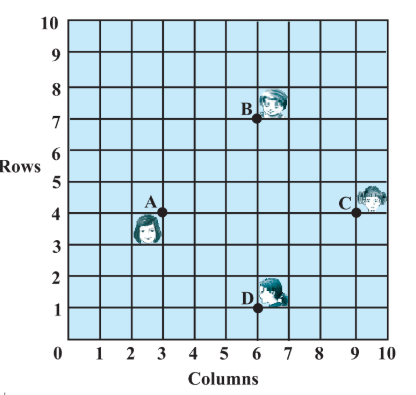
Answer:
The coordinates of the points:

The distance between two points 

Hence,




And the lengths of diagonals:


So, here it can be seen that all sides of quadrilateral ABCD are of the same lengths and diagonals are also having the same length.
Therefore, quadrilateral ABCD is a square and Champa is saying right.
Q6 (i) Name the type of quadrilateral formed, if any, by the following points, and give reasons for your answer: (– 1, – 2), (1, 0), (– 1, 2), (– 3, 0)
Answer:
Let the given points 
The distance formula:





Finding the length of the diagonals:


It is clear that all sides are of the same lengths and also the diagonals have the same lengths.
Hence, the given quadrilateral is a square.
Q6 (ii) Name the type of quadrilateral formed, if any, by the following points, and give reasons for your answer: (–3, 5), (3, 1), (0, 3), (–1, – 4)
Answer:
Let the given points 
The distance formula:





All the sides of the given quadrilateral have different lengths.
Therefore, it is only a general quadrilateral and not a specific one like square, rectangle, etc.
Q6 (iii) Name the type of quadrilateral formed, if any, by the following points, and give reasons for your answer: (4, 5), (7, 6), (4, 3), (1, 2)
Answer:
Let the given points 
The distance formula:





And the diagonals:


Here we can observe that the opposite sides of this quadrilateral are of the same length.
However, the diagonals are of different lengths.
Therefore, the given points are the vertices of a parallelogram.
Q7 Find the point on the x-axis which is equidistant from (2, –5) and (–2, 9).
Answer:
Let the point which is equidistant from 

Then, we have
Distance AX: 
and Distance BX 
According to the question, these distances are equal length.
Hence we have,


Solving this to get the required coordinates.
Squaring both sides we get,



Or, 
Hence the point is .
Q8 Find the values of y for which the distance between the points P(2, – 3) and Q(10, y) is 10 units.
Answer:
Given the distance between the points 

The distance formula :

So, given 

After squaring both sides




Therefore, the values are .
Q9 If Q(0, 1) is equidistant from P(5, –3) and R(x, 6), find the values of x. Also, find the distances QR and PR.
Answer:
Given 


Then, the distances 
Distance 
Distance 

Squaring both sides, we get


The points are: 
CASE I: when R is 
The distances QR and PR.


CASE II: when R is 
The distances QR and PR.


Q10 Find a relation between x and y such that the point (x, y) is equidistant from the point (3, 6) and (– 3, 4).
Answer:
Let the point 


Then, the distances 



Squaring both sides: we obtain


![\left [\because a^2-b^2 = (a+b)(a-b) \right ]](http://careerssutra.com/wp-content/plugins/a3-lazy-load/assets/images/lazy_placeholder.gif)


Thus, the relation is between x and y.
Coordinate Geometry Class 10 Exercise:7.2
Q1 Find the coordinates of the point which divides the join of (–1, 7) and (4, –3) in the ratio 2 : 3.
Answer:
Let the coordinates of point 



Section formula: 
Substituting the values in the formula:
Here, 


Hence the coordinate is .
Q2 Find the coordinates of the points of trisection of the line segment joining (4, –1) and (–2, –3).
Answer:
Let the trisection of the line segment 



Then,
Section formula: 
By observation point, P divides AB internally in the ratio 
Hence, 
Substituting the values in the equation we get;



And by observation point Q, divides AB internally in the ratio 
Hence, 
Substituting the values in the equation above, we get



Hence, the points of trisections are and
Q3 To conduct Sports Day activities, in your rectangular shaped school ground ABCD, lines have been drawn with chalk powder at a distance of 1m each. 100 flower pots have been placed at a distance of 1m from each other along AD, as shown in Fig. 7.12. Niharika runs 1/4 th the distance AD on the 2nd line and posts a green flag. Preet runs 1/5th the distance AD on the eighth line and posts a red flag. What is the distance between both the flags? If Rashmi has to post a blue flag exactly halfway between the line segment joining the two flags, where should she post her flag



Answer:
Niharika posted the green flag at the distance P, i.e.,


Therefore, the coordinates of this point 

Similarly, Preet posted red flag at 


Therefore, the coordinates of this point Q are 
The distance 

and the point at which Rashmi should post her Blue Flag is the mid-point of the line joining these points. Let this point be 
Then, by Section Formula,



Therefore, Rashmi should post her Blue Flag at 22.5 m on the 5th line.
Q4 Find the ratio in which the line segment joining the points (– 3, 10) and (6, – 8) is divided by (– 1, 6).
Answer:
Let the ratio be : 
Then, By section formula:

Given point 



Hence, the point divides the line AB in the ratio .
Q5 Find the ratio in which the line segment joining A(1, – 5) and B(– 4, 5) is divided by the x-axis. Also find the coordinates of the point of division.
Answer:
Let the point on the x-axis be 

Then, we have
Section formula:



Hence, the value of k will be: 
Therefore, the x-axis divides the line in the ratio 
Putting the value of 


Q6 If (1, 2), (4, y), (x, 6) and (3, 5) are the vertices of a parallelogram taken in order, find x and y.
Answer:
Let the given points 
Since the diagonals of a parallelogram bisect each other. Intersection point O of diagonal AC and BD also divides these diagonals.
Therefore, O is the mid-point of AC and BD.
The coordinates of the point O when it is mid-point of AC.

The coordinates of the point O when it is mid-point of BD.

Since both coordinates are of same point O.
Therefore,


Or,

Q7 Find the coordinates of point A, where AB is the diameter of a circle whose centre is (2, – 3) and B is (1, 4).
Answer:
As the centre point 
Then, the coordinates of point A will be 
Given point 
Therefore,



Therefore, the coordinates of A are
Q8 If A and B are (- 2, – 2) and (2, – 4), respectively, find the coordinates of P such that AP = 3 AB 7 and P lies on the line segment AB.
Answer:
From the figure:



As 

Now, from the section formula, we can find the coordinates of Point P.
Section Formula:




Q9 Find the coordinates of the points which divide the line segment joining A (– 2, 2) and B(2, 8) into four equal parts.
Answer:
From the figure:



Points C, D, and E divide the line segment AB into four equal parts.
Now, from the section formula, we can find the coordinates of Point C, D, and E.
Section Formula:

Here point D divides the line segment AB into two equal parts hence


Now, point C divides the line segment AD into two equal parts hence


Also, point E divides the line segment DB into two equal parts hence


Q10 Find the area of a rhombus if its vertices are (3, 0), (4, 5), (– 1, 4) and (– 2, – 1) taken in order.
Answer:
From the figure:
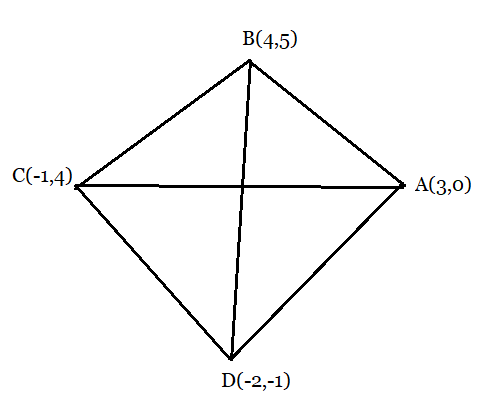


Let the vertices of the rhombus are:

Area of the rhombus ABCD is given by;

Hence we have to find the lengths of the diagonals AC and BD of the rhombus.
The distance formula:

Length of the diagonal AC:

Length of the diagonal BD:

Thus, the area will be,


Coordinate Geometry Class 10 Exercise:7.3
Q 1 (i) Find the area of the triangle whose vertices are : (2, 3), (–1, 0), (2, – 4)
Answer:
As we know, the area of a triangle with vertices (x1,x2) ,(y1, y2) and (z1 z2 ) is given by :

So Area of a triangle whose vertices are(2, 3), (–1, 0)and (2, – 4) is
![A= \frac{1}{2}[2(0-(-4))+(-1)(-4-3)+2(3-0)]](http://careerssutra.com/wp-content/plugins/a3-lazy-load/assets/images/lazy_placeholder.gif)
![A= \frac{1}{2}[8+7+6]](http://careerssutra.com/wp-content/plugins/a3-lazy-load/assets/images/lazy_placeholder.gif)
![A= \frac{1}{2}[21]](http://careerssutra.com/wp-content/plugins/a3-lazy-load/assets/images/lazy_placeholder.gif)


Hence, the area of the triangle is 10.5 per unit square.
Q1 (ii) Find the area of the triangle whose vertices are (–5, –1), (3, –5), (5, 2)
Answer:
From the figure:



Area of the triangle is given by:
![Area = \frac{1}{2}\left [ x_{1}(y_{2}-y_{3})+x_{2}(y_{3}-y_{1})+x_{3}(y_{1}-y_{2}) \right ]](http://careerssutra.com/wp-content/plugins/a3-lazy-load/assets/images/lazy_placeholder.gif)
Substituting the values in the above equation, we obtain
![Area = \frac{1}{2}\left [ (-5)((-5)-(-2))+3(2-(1))+5(-1-(-5)) \right ]](http://careerssutra.com/wp-content/plugins/a3-lazy-load/assets/images/lazy_placeholder.gif)
![= \frac{1}{2}\left [ 35+9+20 \right ] = 32 \ square\ units.](http://careerssutra.com/wp-content/plugins/a3-lazy-load/assets/images/lazy_placeholder.gif)
Q2 (i) In each of the following find the value of ‘k’, for which the points are collinear. (7, –2), (5, 1), (3, k)
Answer:
The points (7, –2), (5, 1), (3, k) are collinear if the area of the triangle formed by the points will be zero.
Area of the triangle is given by:
![Area = \frac{1}{2}\left [ x_{1}(y_{2}-y_{3})+x_{2}(y_{3}-y_{1})+x_{3}(y_{1}-y_{2}) \right ] = 0](http://careerssutra.com/wp-content/plugins/a3-lazy-load/assets/images/lazy_placeholder.gif)
Substituting the values in the above equation, we obtain
![\frac{1}{2}\left [ 7(1-k)+5(k-(-2))+3(-2-1) \right ] = 0](http://careerssutra.com/wp-content/plugins/a3-lazy-load/assets/images/lazy_placeholder.gif)
![\left [ 7-7k+5k+10-9 \right ] = 0](http://careerssutra.com/wp-content/plugins/a3-lazy-load/assets/images/lazy_placeholder.gif)


Hence, the points are collinear for k=4 .
Q2 (ii) In each of the following find the value of ‘k’, for which the points are collinear. (8, 1), (k, – 4), (2, –5)
Answer:
The points (8,1), (k, -4), (2,-5) are collinear if the area of the triangle formed by these points will be zero.
Area of the triangle is given by:
![Area = \frac{1}{2}\left [ x_{1}(y_{2}-y_{3})+x_{2}(y_{3}-y_{1})+x_{3}(y_{1}-y_{2}) \right ] = 0](http://careerssutra.com/wp-content/plugins/a3-lazy-load/assets/images/lazy_placeholder.gif)
Substituting the values in the above equation, we obtain
![\frac{1}{2}\left [ 8(-4-(-5))+k((-5)-1)+2(1-(-4)) \right ] = 0](http://careerssutra.com/wp-content/plugins/a3-lazy-load/assets/images/lazy_placeholder.gif)



Hence, the points are collinear for k = 3 .
Q3 Find the area of the triangle formed by joining the mid-points of the sides of the triangle whose vertices are (0, –1), (2, 1) and (0, 3). Find the ratio of this area to the area of the given triangle.
Answer:
From the figure:
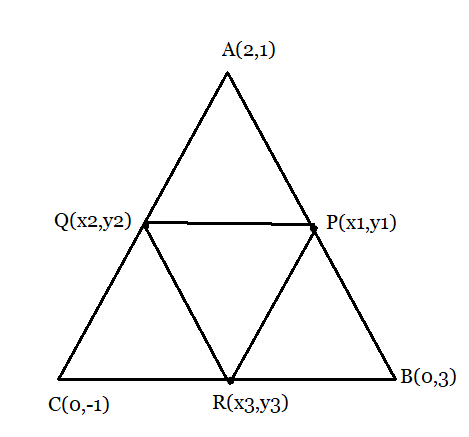


The coordinates of the point P, Q, and R are:
Point P is the midpoint of side AB, hence the coordinates of P are :

Point Q is the midpoint of side AC, hence the coordinates of Q are :

Point R is the midpoint of side BC, hence the coordinates of R are :

Hence, the area of the triangle formed by the midpoints PQR will be,
![Area_{(PQR)} = \frac{1}{2}\left [ x_{1}(y_{2}-y_{3})+x_{2}(y_{3}-y_{1})+x_{3}(y_{1}-y_{2}) \right ]](http://careerssutra.com/wp-content/plugins/a3-lazy-load/assets/images/lazy_placeholder.gif)
![= \frac{1}{2}\left [ (2-1)+1(1-0)+0(0-2) \right ]](http://careerssutra.com/wp-content/plugins/a3-lazy-load/assets/images/lazy_placeholder.gif)

And the area formed by the triangle ABC will be:
![Area_{(ABC)} = \frac{1}{2}\left [ 0(1-3)+2(3-(-1))+0(-1-1) \right ]](http://careerssutra.com/wp-content/plugins/a3-lazy-load/assets/images/lazy_placeholder.gif)
![= \frac{1}{2}\left [ 8 \right ] = 4\ square\ units.](http://careerssutra.com/wp-content/plugins/a3-lazy-load/assets/images/lazy_placeholder.gif)
Thus, the ratio of Area of to the Area of will be .
Q4 Find the area of the quadrilateral whose vertices, taken in order, are (– 4, – 2), (– 3, – 5), (3, – 2) and (2, 3).
Answer:
From the figure:



The coordinates are 
Divide the quadrilateral into 2 parts of triangles.
Then the area will be, 
Area of the triangle formed by ABC will be,
![Area_{(ABC)} = \frac{1}{2}\left [ (-4)((-5)-(-2))+(-3)((-2)-(-2))+3((-2)-(-2)) \right ]](http://careerssutra.com/wp-content/plugins/a3-lazy-load/assets/images/lazy_placeholder.gif)
![= \frac{1}{2}\left [ 12+0+9 \right ] = \frac{21}{2}\ Square\ units.](http://careerssutra.com/wp-content/plugins/a3-lazy-load/assets/images/lazy_placeholder.gif)
Area of the triangle formed by ADC will be,
![Area_{(ADC)} = \frac{1}{2}\left [ (-4)((-2)-(-3))+3(3-(-2))+2((-2)-(-2)) \right ]](http://careerssutra.com/wp-content/plugins/a3-lazy-load/assets/images/lazy_placeholder.gif)
![= \frac{1}{2}\left [ 20+15+0 \right ] = \frac{35}{2}\ Square\ units.](http://careerssutra.com/wp-content/plugins/a3-lazy-load/assets/images/lazy_placeholder.gif)
Therefore, the area of the quadrilateral will be:

Alternatively,
The points A and C are in the same ordinates.
Hence, the length of base AC will be 
Therefore,
Area of triangle ABC:

Area of triangle ADC:

Therefore, the area will be,
Q5 You have studied in Class IX, (Chapter 9, Example 3), that a median of a triangle divides it into two triangles of equal areas. Verify this result for D ABC whose vertices are A(4, – 6), B(3, –2) and C(5, 2).
Answer:
From the figure:



The coordinates of midpoint M of side BC is:

Now, calculating the areas of the triangle ABM and ACM :
Area of triangle, ABM:
![Area_{(ABM)} = \frac{1}{2}\left [ 4((-2)-0)+3(0-(-6))+4((-6)-(-2)) \right ]](http://careerssutra.com/wp-content/plugins/a3-lazy-load/assets/images/lazy_placeholder.gif)
![= \frac{1}{2}\left [ -8+18-16 \right ] = 3\ Square\ units.](http://careerssutra.com/wp-content/plugins/a3-lazy-load/assets/images/lazy_placeholder.gif)
Area of triangle, ACM:
![Area_{(ACM)} = \frac{1}{2}\left [ 4(0-(-2))+4(2-(-6))+5((-6)-0) \right ]](http://careerssutra.com/wp-content/plugins/a3-lazy-load/assets/images/lazy_placeholder.gif)
![= \frac{1}{2}\left [ -8+32-30 \right ] = -3\ Square\ units.](http://careerssutra.com/wp-content/plugins/a3-lazy-load/assets/images/lazy_placeholder.gif)
However, the area cannot be negative, Therefore, area of 
Clearly, the median AM divided the in two equal areas.
Coordinate Geometry Class 10 Exercise:7.4
Q1 Determine the ratio in which the line 2x + y – 4 = 0 divides the line segment joining the points A(2, – 2) and B(3, 7).
Answer:
Let the line divide the line segment AB in the ratio 
Then, the coordinates of point C will be:

Point C will also satisfy the given line equation 




Therefore, the ratio in which the line divides the line segment joining the points and is internally.
Q2 Find a relation between x and y if the points (x, y), (1, 2) and (7, 0) are collinear.
Answer:
If the points 
The area of the triangle is given by,
![Area = \frac{1}{2}\left [ x_{1}(y_{2}-y_{3})+x_{2}(y_{3}-y_{1})+x_{3}(y_{1}-y_{2}) \right ] = 0](http://careerssutra.com/wp-content/plugins/a3-lazy-load/assets/images/lazy_placeholder.gif)
Substituting the values in the above equation, we have
![Area = \frac{1}{2}\left [ x(2-0)+1(0-y)+7(y-2) \right ]= 0](http://careerssutra.com/wp-content/plugins/a3-lazy-load/assets/images/lazy_placeholder.gif)

Or,

Hence, the required relation between x and y is .
Q3 Find the center of a circle passing through the points (6, – 6), (3, – 7) and (3, 3).
Answer:
From the figure:



Let the center point be 
Then the radii of the circle 
The distance OA:

The distance OB:

The distance OC:

Equating the radii of the same circle.
When equating, 

Squaring both sides and applying 



……………………………..(1)
When equating, 

Squaring both sides and applying 



Now, adding the equations (1) and (2), we get


From equation (1), we get



Therefore, the centre of the circle is .
Q4 The two opposite vertices of a square are (–1, 2) and (3, 2). Find the coordinates of the other two vertices.
Answer:
From the figure:
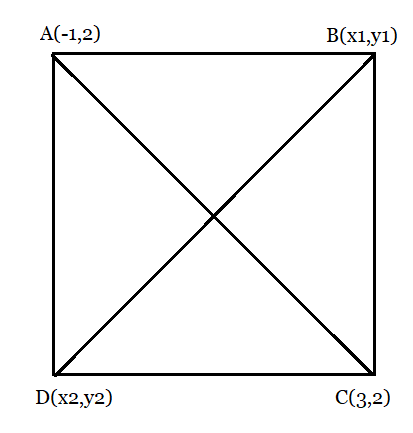


We know that the sides of a square are equal to each other.
Therefore, AB = BC
So,

Squaring both sides, we obtain

Now, doing 
We get

Hence 
Applying the Pythagoras theorem to find out the value of y.




Q5 (i) The Class X students of a secondary school in Krishinagar have been allotted a rectangular plot of land for their gardening activity. Sapling of Gulmohar is planted on the boundary at a distance of 1m from each other. There is a triangular grassy lawn in the plot as shown in Fig. 7.14. The students are to sow seeds of flowering plants on the remaining area of the plot. (i) Taking A as origin, find the coordinates of the vertices of the triangle.



Answer:
Taking A as origin then, the coordinates of P, Q, and R can be found by observation:
Coordinates of point P is 
Coordinates of point Q is 
Coordinates of point R is 
The area of the triangle, in this case, will be:
![Area =\frac{1}{2}\left [ x_{1}(y_{2}-y_{3})+x_{2}(y_{3}-y_{1})+x_{3}(y_{1}-y_{2}) \right ]](http://careerssutra.com/wp-content/plugins/a3-lazy-load/assets/images/lazy_placeholder.gif)
![=\frac{1}{2}\left [ 4(2-5)+3(5-6)+6(6-2) \right ]](http://careerssutra.com/wp-content/plugins/a3-lazy-load/assets/images/lazy_placeholder.gif)
![=\frac{1}{2}\left [ -12-3+24\right ] = \frac{9}{2}\ Square\ units.](http://careerssutra.com/wp-content/plugins/a3-lazy-load/assets/images/lazy_placeholder.gif)
Q5 (ii) The Class X students of a secondary school in Krishinagar have been allotted a rectangular plot of land for their gardening activity. Sapling of Gulmohar is planted on the boundary at a distance of 1m from each other. There is a triangular grassy lawn in the plot as shown in Fig. 7.14. The students are to sow seeds of flowering plants on the remaining area of the plot. (ii) What will be the coordinates of the vertices of D PQR if C is the origin? Also, calculate the areas of the triangles in these cases. What do you observe?



Answer:
Taking C as origin, then CB will be x-axis and CD be y-axis.
The coordinates fo the vertices P, Q, and R are: 
The area of the triangle, in this case, will be:
![Area =\frac{1}{2}\left [ x_{1}(y_{2}-y_{3})+x_{2}(y_{3}-y_{1})+x_{3}(y_{1}-y_{2}) \right ]](http://careerssutra.com/wp-content/plugins/a3-lazy-load/assets/images/lazy_placeholder.gif)
![=\frac{1}{2}\left [ 12(6-3)+13(3-2)+10(2-6) \right ]](http://careerssutra.com/wp-content/plugins/a3-lazy-load/assets/images/lazy_placeholder.gif)
![=\frac{1}{2}\left [ 36-13+40 \right ] = \frac{9}{2}\ Square\ units.](http://careerssutra.com/wp-content/plugins/a3-lazy-load/assets/images/lazy_placeholder.gif)
It can be observed that in both cases the area is the same so, it means that the area of any figure does not depend on the reference which you have taken.
Q6 The vertices of a are A(4, 6), B(1, 5) and C(7, 2). A line is drawn to intersect sides AB and AC at D and E respectively, such that Calculate the area of the and compare it with the area of .
Answer:
From the figure:
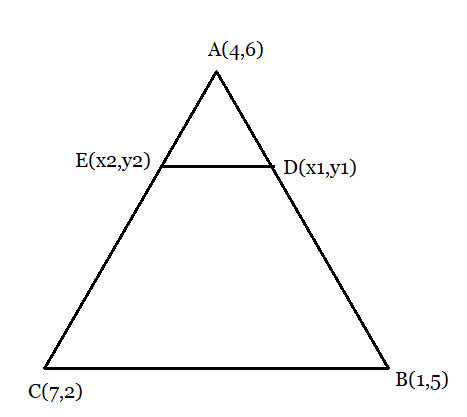


Given ratio:

Therefore, D and E are two points on side AB and AC respectively, such that they divide side AB an AC in the ratio of 
Section formula:

Then, coordinates of point D:

Coordinates of point E:


Then, the area of a triangle:
![= \frac{1}{2}\left [ x_{1}(y_{2}-y_{3})+x_{2}(y_{3}-y_{1})+x_{3}(y_{1}-y_{2}) \right ]](http://careerssutra.com/wp-content/plugins/a3-lazy-load/assets/images/lazy_placeholder.gif)
Substituting the values in the above equation,
![Area\ of\ \triangle ADE = \frac{1}{2}\left [ 4\left ( \frac{23}{4} - \frac{20}{4}\right )+\frac{13}{4}\left ( \frac{20}{4} - 6 \right )+\frac{19}{4}\left (6-\frac{23}{4} \right )\right ]](http://careerssutra.com/wp-content/plugins/a3-lazy-load/assets/images/lazy_placeholder.gif)
![= \frac{1}{2}\left [ 3-\frac{13}{4} +\frac{19}{16}\right ] = \frac{1}{2}\left [ \frac{48-52+19}{16} \right ] = \frac{15}{32}\ square\ units.](http://careerssutra.com/wp-content/plugins/a3-lazy-load/assets/images/lazy_placeholder.gif)
![Area\ of\ \triangle ABC = \frac{1}{2}\left [ 4(5-2)+1(2-6)+7(6-5) \right ]](http://careerssutra.com/wp-content/plugins/a3-lazy-load/assets/images/lazy_placeholder.gif)
![= \frac{1}{2}\left [ 12-4+7 \right ] = \frac{15}{2}\ Square\ units.](http://careerssutra.com/wp-content/plugins/a3-lazy-load/assets/images/lazy_placeholder.gif)
Hence the ratio between the areas of and is
Q7 (1) Let A (4, 2), B(6, 5) and C(1, 4) be the vertices of . The median from A meets BC at D. Find the coordinates of the point D.
Answer:
From the figure:
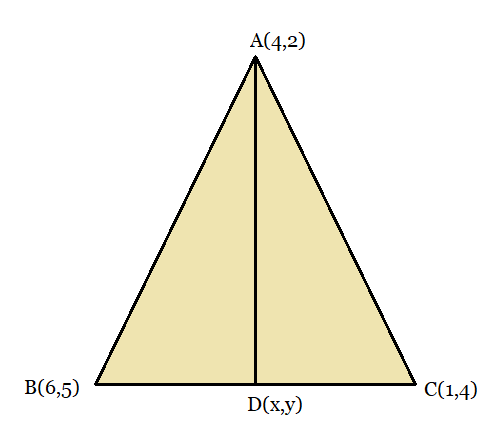


Let AD be the median of the triangle
Then, D is the mid-point of BC
Coordinates of Point D:

Q7 (ii) Let A (4, 2), B(6, 5) and C(1, 4) be the vertices of D ABC. Find the coordinates of the point P on AD such that AP: PD = 2: 1
Answer:
From the figure,
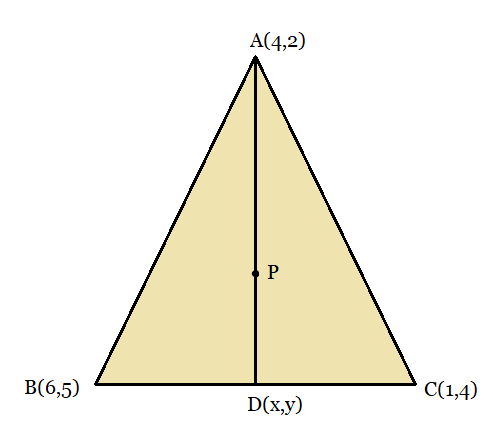


The point P divides the median AD in the ratio, AP: PD = 2: 1
Hence using the section formula,


Q7 (iii) Let A (4, 2), B(6, 5) and C(1, 4) be the vertices of D ABC. Find the coordinates of points Q and R on medians BE and CF respectively such that BQ: QE = 2: 1 and CR: RF = 2: 1
Answer:
From the figure,
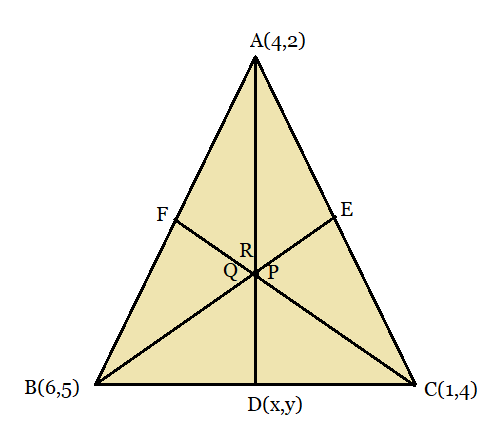



Hence using the section formula,



Hence using the section formula,


Q7 (iv) Let A (4, 2), B(6, 5) and C(1, 4) be the vertices of D ABC. What do you observe?
Answer:
We observed that the coordinates of P, Q, and R are the same. Therefore, all these are representing the same point on the plane. i.e., the centroid of the triangle.
Q7 (v) Let A (4, 2), B(6, 5) and C(1, 4) be the vertices of . If are the vertices of , find the coordinates of the centroid of the triangle.
Answer:
From the figure, 


Let the median be AD which divides the side BC into two equal parts.
Therefore, D is the mid-point of side BC.
Coordinates of D:

Let the centroid of this triangle be O.
Then, point O divides the side AD in a ratio 2:1.
Coordinates of O:


Q8 ABCD is a rectangle formed by the points A(–1, –1), B(– 1, 4), C(5, 4) and D(5, – 1). P, Q, R and S are the mid-points of AB, BC, CD and DA respectively. Is the quadrilateral PQRS a square? a rectangle? or a rhombus? Justify your answer.
Answer:
From the figure:



P is the mid-point of side AB.
Therefore, the coordinates of P are, 
Similarly, the coordinates of Q, R and S are: 
The distance between the points P and Q:

and the distance between the points Q and R:

Distance between points R and S:

Distance between points S and P:

Distance between points P and R the diagonal length:

Distance between points Q and S the diagonal length:

Hence, it can be observed that all sides have equal lengths. However, the diagonals are of different lengths.
Therefore, PQRS is a rhombus.